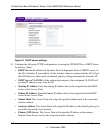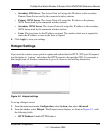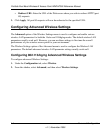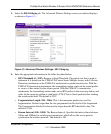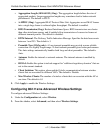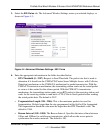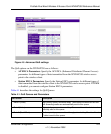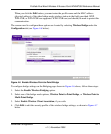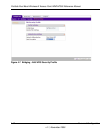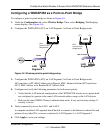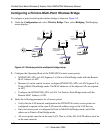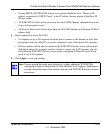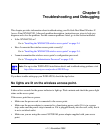
ProSafe Dual Band Wireless-N Access Point WNDAP350 Reference Manual
4-10 Advanced Configuration
v1.1, November 2009
Enabling Wireless Bridging
The ProSafe Dual Band Wireless-N Access Point WNDAP350 lets you build large bridged
wireless networks. Select the desired wireless access point mode for your environment:
• Wireless Point-to-Point Bridge. In this mode, the WNDAP350 can communicate with
another bridge mode wireless access point. Select the Enable Wireless Client Association
option to enable wireless clients to associate with this access point.
When you click the Edit button, you must enter the Profile Name and the MAC address
(physical address) of the other Bridge mode wireless access point in the fields provided. WEP,
WPA-PSK, or WPA2-PSK are supported. WPA2-PSK can (and should) be used to protect this
communication.
• Wireless Point-to-Multi-Point Bridge. Select this only if this WNDAP350 is the “Master”
for a group of bridge-mode wireless access points. Select the Enable Wireless Client
Association option to enable wireless clients to associate with this access point.
The other bridge-mode wireless access points must be set to point-to-point bridge mode, using
the MAC address of this WNDAP350. They then send all traffic to this “Master”, rather than
communicate directly with each other.
Data 3 (Background) Lowest priority queue, high throughput. Bulk data that requires maxi-
mum throughput and is not time-sensitive is sent to this queue (FTP
data, for example).
AIFS (Arbitration Inter-Frame
Space)
Specifies a wait time (in milliseconds) for data frames. Valid values for
AIFS are 1 through 255.
cwMin (Minimum Contention
Window)
Upper limit (in milliseconds) of a range from which the initial random
backoff wait time is determined. Valid values for the “cwmin” are 1, 3, 7,
15, 31, 63, 127, 255, 511, or 1024. The value for cwMin must be lower
than the value for cwMax.
cwMax (Maximum Contention
Window)
Upper limit (in milliseconds) for the doubling of the random backoff
value. Valid values for the “cwmax” are 1, 3, 7, 15, 31, 63, 127, 255,
511, or 1024. The value for cwMax must be higher than the value for
cwMin.
Max. Burst Length Specifies (in milliseconds) the Maximum Burst Length allowed for
packet bursts on the wireless network. A packet burst is a collection of
multiple frames transmitted without header information. Valid values for
maximum burst length are 0.0 through 999.9.
Table 4-1. QoS Queues and Parameters
QoS Queue Description



